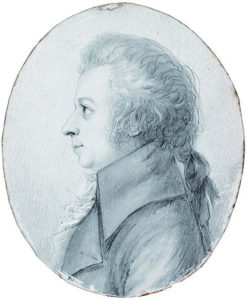This post is a sort of hybrid of what we might call a combination of “Music History Tuesday” (if such a thing actually existed) and Dr. Bob Prescribes. Here we go!

We mark the completion – on September 29, 1789 – 231 years ago today – of Mozart’s Clarinet Quintet in A Major, K. 581. It remains one of Mozart’s (admittedly many) chamber music masterworks, and among the handful of greatest early works for the clarinet, all of which – not coincidentally – were composed by Mozart himself.
We often take for granted that the instruments of the Western orchestra have existed in their present form for many hundreds of years, and that they all came into existence at more or less the same time.
In fact, like any ongoing technology, instrumental design is in a constant state of “tweak.” Granted, some instruments – like the violin, viola, and violoncello (aka the “cello”) – achieved a certain evolutionary equilibrium (I’m loath to say “perfection”) by the early eighteenth century. (For our reference, Antonio Stradivari lived from 1644-1737.) But the vast majority of orchestral instruments did not achieve their present form and design until the mid- to late-nineteenth century; in some cases, not until the twentieth century. For example, the standard double horn in B-flat, colloquially known in English-speaking countries as the “French horn”, wasn’t invented until 1897. While the oboe – hautbois, or high woodwind – is a relatively ancient instrument, it did not attain its current form until 1906, when Georges Gillet invented what today is its standard 45-key system. Today’s standard trumpet in B-flat was invented between 1910 and 1913.
Musical instruments continue to evolve, sometimes in small increments and sometimes, under certain circumstances, by great leaps. Great leaps in evolution are usually spurred on by great climatic upheaval, creating the need for creatures to adapt or, like the acting career of Mel Gibson, go extinct. The “great environmental upheaval” that kick-started the development of “modern” Western instruments was the invention of opera around the year 1600.
Operas – stage plays set to music – requires instrumental accompaniment. Increasingly, that instrumental accompaniment was employed to not just “back up” the singers but to create sonic scenery: to illustrate the action on stage, be it a pastoral scene, or a thunderstorm, or a hunt, or whatever. This ever-growing operatic instrumental ensemble came to be called by the Greek name for the position in which they sat, at the front lip of the stage: the orchestra.

Before the opera orchestra came into existence, most wind and brass instruments were built in one piece (making them difficult to tune and thus play in tune with other instruments); had a limited overall range from top-to-bottom; and limited number of pitches available within that range. Such relatively primitive folk instruments as the shawm (the ancestor of the oboe), the chalumeau (the ancestor of the clarinet), and the dulcian (the ancestor of the bassoon) could sound fine on their own, but they lacked the pitch resources required by opera composers and the ability to play in tune with other instruments. (Modern wind and brass instruments are made in pieces, allowing a player to slightly extend or contract the size of the instrument in order to “tune” them.)
Consequently, starting in the early seventeenth, instrumental evolution went into high evolutionary gear in order to satisfy the ever-growing needs of the opera orchestra and later, the self-standing concert orchestra (which itself evolved from the opera orchestra). ……
Continue Reading, only on Patreon
Become a Patron!